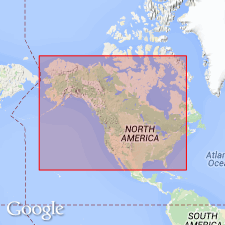
- Usage in publication:
-
- Wilmington beds*
- Modifications:
-
- Named
- Dominant lithology:
-
- Marl
- AAPG geologic province:
-
- Atlantic Coast basin
Summary:
Pg. 344, and chart opp. p. 334. Wilmington beds. See Clark, USGS Bull 83, 1891, p. 48-50, also note under E22. [The note under E22 is:] This [the Shark River beds of New Jersey], like the Eocene of North Carolina, is regarded by Harris as newer than that of Maryland and Virginia, which has been included under name Pamunkey by Darton. [Assigned to Claibornian in table opp. p. 334.]
Apparently named from exposures at Wilmington, southeastern coast of NC.
[GNC remark (ca. 1936, US geologic names lexicon, USGS Bull. 896, p. 2345): On p. 48-50 of USGS Bull. 83 W.B. Clark described the Eocene deposits of North Carolina but did not apply a geographic name to them. In region described by Clark the deposits are now divided into Castle Hayne marl (of upper Eocene, Jackson, age) above and Trent marl (lower Miocene) below, both of which were evidently included in "Wilmington beds."
Source: US geologic names lexicon (USGS Bull. 896, p. 2345).

- Usage in publication:
-
- Wilmington†
- Modifications:
-
- Overview
- Abandoned
- AAPG geologic province:
-
- Atlantic Coast basin
Summary:
On p. 48-50 of USGS Bulletin 83, W.B. Clark described the Eocene deposits of NC, but did not apply a geographic name to them. In region described by Clark, the deposits are now divided into Castle Hayne marl (of upper Eocene (Jackson) age) above and Trent marl (lower Miocene) below, both of which were evidently included in "Wilmington beds."
Source: GNU records (USGS DDS-6; Reston GNULEX).
For more information, please contact Nancy Stamm, Geologic Names Committee Secretary.
Asterisk (*) indicates published by U.S. Geological Survey authors.
"No current usage" (†) implies that a name has been abandoned or has fallen into disuse. Former usage and, if known, replacement name given in parentheses ( ).
Slash (/) indicates name conflicts with nomenclatural guidelines (CSN, 1933; ACSN, 1961, 1970; NACSN, 1983, 2005, 2021). May be explained within brackets ([ ]).

